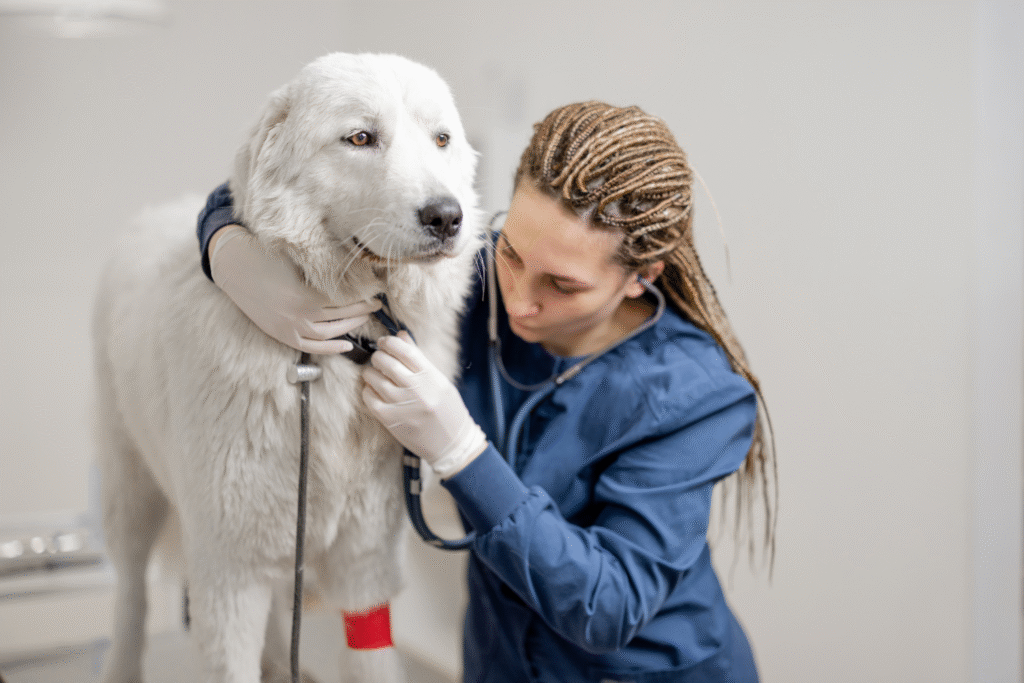Subtle symptoms can hide in plain sight for months.

Heart disease in dogs doesn’t always announce itself with dramatic symptoms. Often, it begins quietly, through small changes in behavior, appetite, or energy that are easy to brush off as aging. But catching those early warning signs can make all the difference between manageable treatment and life-threatening complications. Understanding what your dog’s body is trying to say through its breathing, movement, or mood can save valuable time. Here are the subtle red flags that many owners overlook until it’s too late.
1. Fatigue creeps in long before you expect it.

When a dog that used to zoom around suddenly needs breaks on short walks, it might be an early cardiac issue. Fatigue develops as the heart struggles to circulate oxygen efficiently. According to the American Kennel Club, reduced stamina is one of the first observable signs of heart disease in both large and small breeds. Many owners assume it’s just aging, but the decline often happens faster and more noticeably when the heart is under strain. Spotting this shift early gives vets time to intervene effectively.
2. Subtle coughing may start, especially at night.

A soft, occasional cough that happens mostly after resting or lying down is often dismissed as allergies or a tickle in the throat. Yet, it can signal fluid buildup from congestive heart failure, as stated by the American Veterinary Medical Association. When the heart weakens, blood can back up into the lungs, irritating airways and causing gentle, persistent coughing. If your dog coughs more at night or after exercise, it’s worth mentioning to your vet—it’s often the body’s quiet plea for help.
3. Heavy or rapid breathing becomes the new normal.

Labored breathing that persists when your dog is resting can point to early heart trouble. As reported by the Cornell University College of Veterinary Medicine, dogs with heart disease may breathe faster due to reduced oxygen circulation and mild pulmonary congestion. You might notice your dog’s chest rising more quickly than usual, or they may start avoiding positions that put pressure on their lungs. These tiny changes often appear before any major health crisis, which makes them crucial to catch early.
4. Sudden restlessness at night replaces deep sleep.

When dogs can’t seem to get comfortable, frequently shifting positions, or choosing to sleep sitting up, it can mean their heart is struggling to pump blood effectively. This discomfort can worsen when lying flat, leading to anxiety or pacing in the middle of the night. Many owners chalk it up to old age or arthritis, but it often coincides with hidden circulatory problems. Watching sleep behavior closely provides important clues long before breathing distress becomes visible.
5. Appetite fades, but the reason isn’t obvious.

Loss of interest in food is a common yet underrated sign of heart disease. Poor circulation affects digestion, leading to nausea or stomach discomfort that blunts appetite. The drop in energy that follows makes things worse, as dogs lose the motivation to eat even their favorite treats. If a once-eager eater suddenly leaves meals untouched for days at a time, it’s a good idea to ask for a cardiac check-up instead of assuming pickiness.
6. A swollen belly can mean hidden fluid buildup.

Owners often mistake abdominal swelling for weight gain, but in dogs with heart disease, it’s usually ascites—fluid collecting in the abdomen due to poor circulation. This can make their belly feel tight or cause discomfort when lying down. The change can appear gradually, so it helps to feel your dog’s ribs and waist regularly to detect subtle bloating. By the time the swelling is visible, the disease has often advanced, so early detection matters.
7. Fainting or collapsing may happen after short activity.

When the heart can’t supply enough blood to the brain during exertion, dogs may briefly faint or stumble. These moments are often mistaken for dizziness or tripping, but they’re actually cardiac red flags. Fainting may follow excitement, a quick sprint, or even a sudden bark. If a dog collapses but seems fine moments later, it’s easy to ignore—but such incidents can precede serious arrhythmias that require medical care.
8. The gums may lose their rosy glow.

Healthy gums are usually pink, but heart disease can cause them to appear pale, bluish, or gray due to reduced oxygen in the bloodstream. Checking your dog’s gums regularly is one of the simplest ways to spot early cardiovascular stress. Press gently on the gum and see how fast color returns; if it’s slow or uneven, circulation could be compromised. This subtle test often reveals problems before other symptoms appear.
9. Exercise becomes something they avoid entirely.

Even the most playful dogs may begin declining fetch or long walks when their heart can’t keep up. Owners sometimes think it’s laziness or aging, but it’s often fatigue from poor oxygen delivery. When dogs instinctively limit activity, they’re protecting themselves from strain. The shift usually feels emotional—suddenly, the excitement for walks is replaced by hesitation or disinterest, a quiet clue that their heart may be struggling.
10. Breathing sounds start to change during rest.

A faint wheeze, snore-like sound, or shallow panting that continues during sleep can indicate early heart problems. These noises happen when fluid starts pressing on airways or lungs expand unevenly. While it’s easy to confuse this with normal snoring, a new or worsening sound pattern—especially in breeds that didn’t snore before—can reveal deeper issues. Paying attention to nighttime breathing is one of the simplest early-detection habits you can build.
11. Weight loss sneaks in without any diet change.

When heart disease progresses, the body can lose muscle mass, especially around the spine and hips. This occurs because energy is redirected to keeping circulation stable, leaving less for maintaining muscle. It’s easy to miss since fur hides subtle changes, but feeling along your dog’s back weekly can reveal weight loss early. What looks like “slimming down” may actually be a sign that their heart isn’t keeping up with basic metabolic demands.
12. Their mood and energy start to dim quietly.

Heart disease doesn’t just affect the body—it alters personality. Dogs may seem less enthusiastic about greetings, toys, or cuddles, showing subtle signs of withdrawal. The drop in energy and engagement often feels emotional, but it’s rooted in physical strain. When your dog’s spark seems dimmer, and no amount of rest restores it, that emotional shift could be your final clue that something deeper is happening inside their heart.
